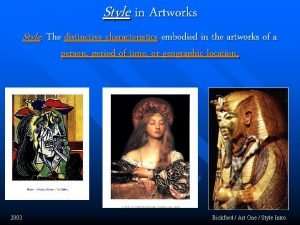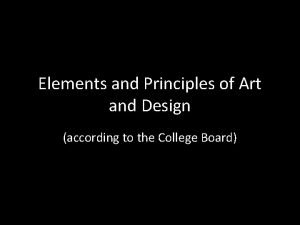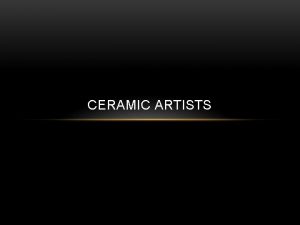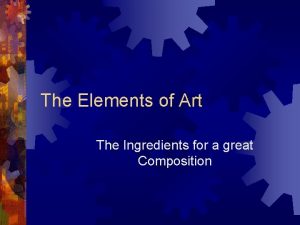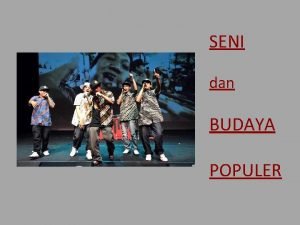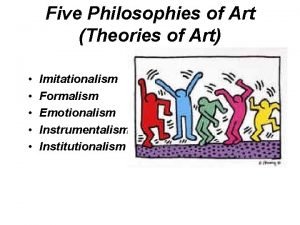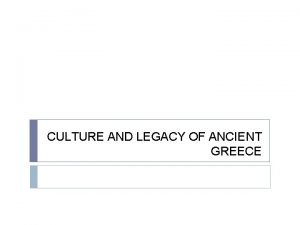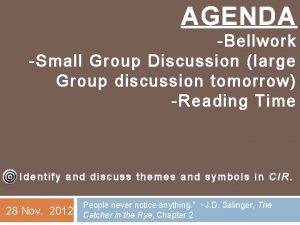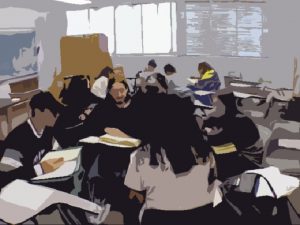Small Group Discussion z Is this artwork a

















- Slides: 17

Small Group Discussion z. Is this artwork a painting or sculpture? z. What do you think it is made of? z. How big is it? z. What is represented? Describe how this work looks. z. For what, do you think, was the work used? z. What could it mean or symbolize? © Diane Mankin

Woman of Willendorf z. Limestone sculpture, 4 ”h. , c. 22 -21, 000 BCE zobese woman - huge breasts, belly, & hips ysimplified round forms - abstracted yface minimized & tiny arms, (feet & ankles broken off) ystylized, patterned marks represent hair zexaggerated parts have reproductive functions - fertility fetish? z. Why worship fertility? © Diane Mankin

PREHISTORIC ART PALEOLITHIC 40, 000 - 8, 000 BCE NEOLITHIC 8, 000 - 1, 500 BCE © Diane Mankin

Paleolithic Art & Culture z“pre-” = before “historic” = written history z“paleo” = “old” “lithic” = “stone” z. BCE = before the common era z. How do we learn about the lives of these early people? y. Paleontology = study of fossilized remains y. Anthropology = study of human kind xgain many clues about prehistoric life through human artifacts © Diane Mankin

Paleolithic Culture z. Hunter-Gatherers joined in small tribes z. Could travel great distances following food sources z. Made stone and bone tools z. Lived in cave mouths or huts & tents made of branches or mammoth bones z. Made small sculptures of stone, bone, & ivory z. Painted cave interiors © Diane Mankin

Paleolithic Small Sculpture z. Woman from Ostrava Petrkovice, Czech Rep. , c. 23, 000 BCE, hematite, 1¾”h yolder than Woman of Willendorf ymade from iron oxide ore (black pigment) ydifferent body type in motion ymore angular carving ymissing limbs and head y. Why was this figure carved in this way? © Diane Mankin

Paleolithic Cave Painting z. Spotted Horses, Pech-Merle cave, Dordogne, France, c. 16, 000 BCE, paint on limestone, 11’ 2” long y. How were these images painted? x. Paint made of pigment mixed with animal glue & saliva blown through the mouth xnegative handprints-paint forms outline y. Why were the horses & hands painted? x. Magical capture of animals? Religious or social ritual practice? x. Signatures? © Diane Mankin

Paleolithic Cave Painting z. Hall of Bulls, Lascaux caves, c. 15, 000 -13, 000 BCE, paint on limestone y. Large cavern with many layers & sizes of painted animals x. How are the animals posed? xnatural swells of cave wall used to emphasize volume of the animal y. Why so many layers and sizes? x. Different artists or different generations? x. Acts as record or calendar of different hunting seasons? © Diane Mankin

Paleolithic Cave Painting z. Because of popularity of sight, it had to be closed in 1963. Why? y. Thousands of visitors let in humidity, CO 2, and pollutants y. Fungus began destroying paintings z. Lascaux II, reproduction of the original caves and paintings, made to accommodate visitors ynext door to original site © Diane Mankin

Paleolithic Cave Painting z. Bird-Headed Man with Bison & Rhinoceros, Lascaux caves, paint on limestone, 9’ long y. Where are these painted figures in the caves? x. Bottom of a 16’ shaft y. Why do you think they are there? y. What was the purpose or meaning of these figures? x. Is this one story? x. Is the man a hunter or a shaman? x. Can we really ever know for sure? © Diane Mankin

Paleolithic Cave Sculpture z. Bison, Le Tuc d’ Audoubert, Ariège, France, c. 13, 000 BCE, 24 & 25” long y. What are the bison made of? y. How did the artist make them? y. What kind of sculpture is this? Free-standing or relief? y. How were details represented? y. How are the bison posed? Similar to or different from the painted creatures? © Diane Mankin

Neolithic Culture z. Ice Age ends and climate becomes warmer z. Bow and arrow, boat developed z. Began crop cultivation & animal domestication yfirst animal to be domesticated? z. Settled into more permanent villages z. Increasingly complex societies developed yfarmers, priests, leaders, soldiers © Diane Mankin

Neolithic Architecture z. Skara Brae, Orkney Islands, Scotland, c. 3100 -2600 BCE y. Stone village with linked houses y. Type of stone construction for walls? x. Corbeling-each course of stone set in slightly x. Opening in center of roof for smoke y. Built-in shelves, beds, benches, hearth, storage niches and tanks xbuilding technique for shelves? x. Post & lintel © Diane Mankin

Neolithic Architecture z. Megalithic Ceremonial and Tomb structures ydolmen - post & lintel (capstone) megaliths originally covered by cairn of rocks ypassage grave - long entrance of post & lintel megaliths leading to a burial chamber, covered by a cairn ymenhirs - “single vertical megaliths” usually set up in regular patterns (alignments or. . . y. Cromlechs - circular arrangements of post & lintel megaliths © Diane Mankin

Neolithic Architecture z. Stonehenge, Salisbury Plain, Wiltshire, England, c. 2750 -1500 BCE yearliest part - deep ditch, 6’ embankment, 330’ “white” circle, heel stone (16’, 35 tons) y. What was added to the site over the years? y. How did the people move these huge stones? x. Sarsens (gray limestone from 23 m. away) up to 50 tons & 20’ h form outer circle (cromlech) x. Trilithons form horseshoe - tallest 24’ xbluestones from Wales, 150 miles away © Diane Mankin

Neolithic Architecture z. Stonehenge, cont. ypost & lintel construction with mortise and tenon joints on trilithons & sarsens y. What was the site used for by the builders? x. Astronomical observatory to mark the summer solstice & other cosmic events? • Why was this important? x. Gathering place for religious, social, and/or political events? x. Current uses? © Diane Mankin

Neolithic Sculpture z. Male & female figures from Cernavoda, Romania, c. 4000 -3500 BCE, ceramic, 4½” h yprepared clay that has been fired - advance in technical skills of artists yrealistic or simplified & abstracted figures? y. How are the figures posed? y. What do their gestures convey? y. What do you think these figures meant to Neolithic people? Use? © Diane Mankin
 Discussion discussion
Discussion discussion The distinctive characteristics of the artwork
The distinctive characteristics of the artwork Which artist utilized benday dots in his artwork
Which artist utilized benday dots in his artwork Critiquing artwork example
Critiquing artwork example Chris van allsburg drawings
Chris van allsburg drawings A feeling of visual equality in shape, form, value, color
A feeling of visual equality in shape, form, value, color Beate kuhn famous artwork
Beate kuhn famous artwork Self reflection images
Self reflection images A feeling of visual equality in shape form value color etc
A feeling of visual equality in shape form value color etc Created when a line becomes connected and encloses space
Created when a line becomes connected and encloses space Pop culture artwork
Pop culture artwork Tujuan karya inovatif
Tujuan karya inovatif Art theories
Art theories Culture or way of living station 1
Culture or way of living station 1 Carmen lomas garza artwork
Carmen lomas garza artwork Works with pattern to make the artwork active
Works with pattern to make the artwork active Seni mencatat
Seni mencatat Contemporary framework meaning
Contemporary framework meaning

